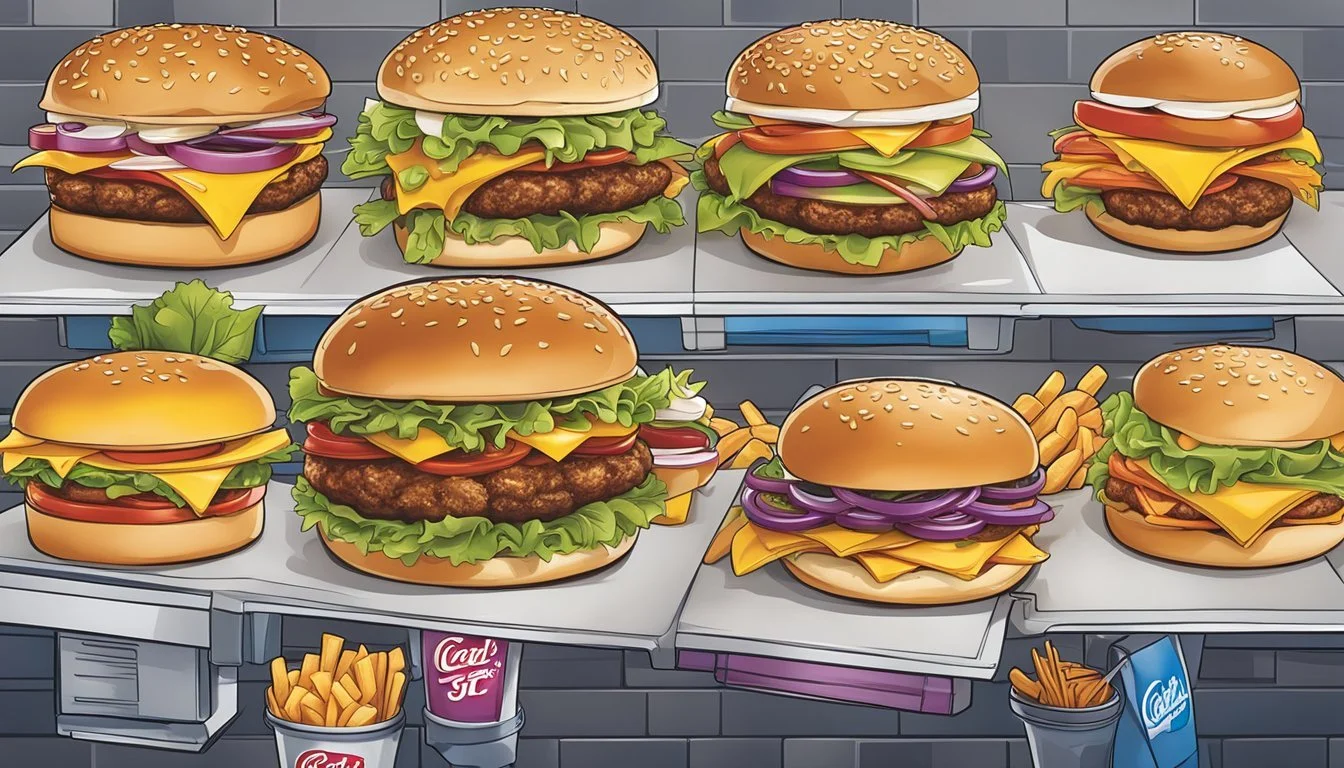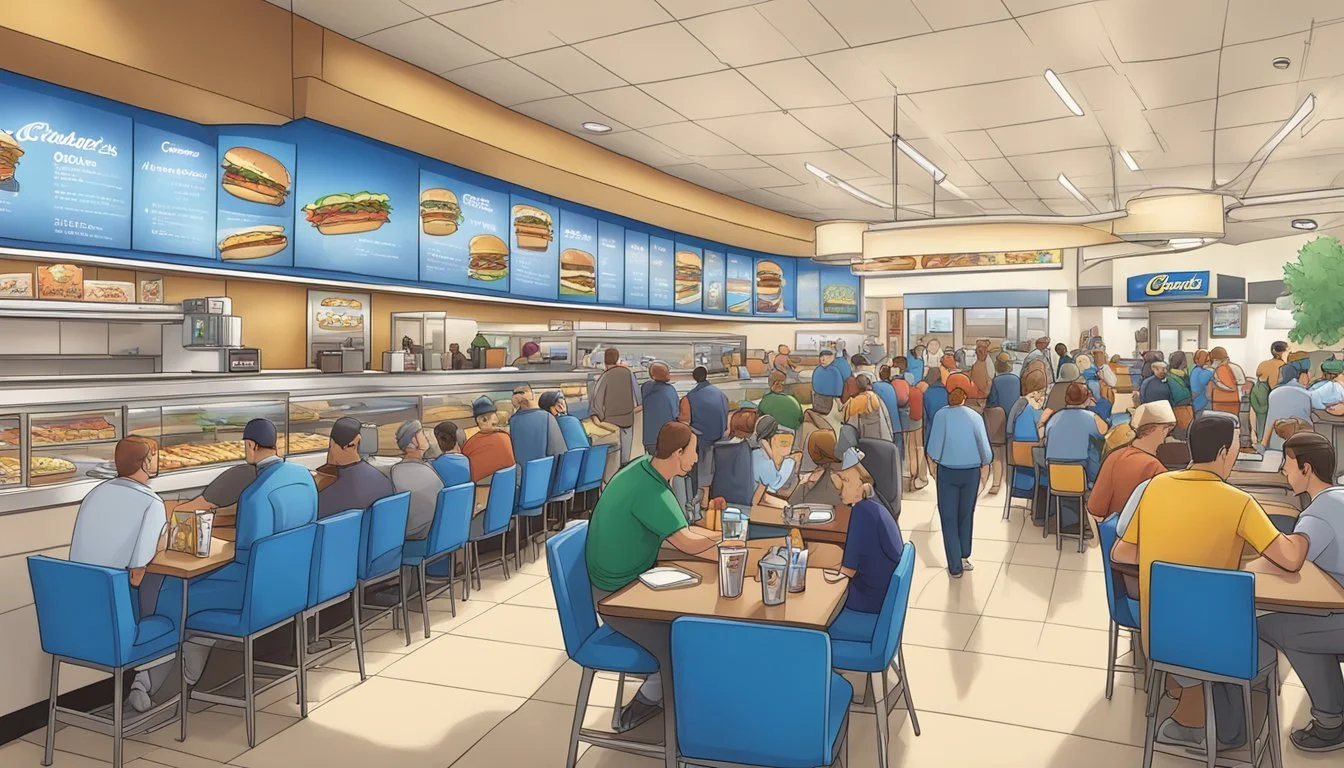Carl's Jr. vs Culver's
An Unbiased Comparison of Burger Excellence
In the landscape of American fast food, the battle for burger supremacy is a continuous saga. Amid the crowded space, Carl’s Jr. and Culver’s stand out not just for their distinctive branding but also for their approaches to serving up classic American fare. Both burger joints have carved their niches within the industry; Carl's Jr. is known for its charbroiled burgers with bold flavors, positioning itself as a go-to option for those craving a more traditional fast food experience. On the other hand, Culver's has built a reputation around its ButterBurgers and commitment to using fresh, never-frozen beef, offering a fast-casual dining experience with a touch of Midwestern charm.
While Carl's Jr. stretches its reach across various states with a menu that includes a wide range of burgers and sandwiches, Culver's emphasizes local sourcing and Wisconsin pride, with regional cheese and frozen custard as hallmarks. Culver's commitment to customization and quality ingredients has earned it accolades, as reflected in recent rankings and customer surveys. Yet, in discussing which joint may be the better choice, it's essential to consider not just the taste and quality of the burgers but also factors like menu variety, value for money, and the overall dining experience.
The debate between Carl’s Jr. and Culver’s extends beyond their flagship burgers — the slight char of a Carl's Jr. patty versus the buttery delight of a Culver's ButterBurger. The question of which is better cannot be answered definitively and often boils down to personal preference. Patrons are divided, with loyal followings on either side, making the comparison between these two contenders a subject of passionate discussion in fast food circles.
History and Background
In exploring the histories of fast-food burger joints Carl's Jr. and Culver's, one uncovers rich narratives of American entrepreneurship and culinary evolution. From the sunny coasts of California to the dairy realms of Wisconsin, these two chains have left indelible marks on the American fast-food landscape.
Carl's Jr. Origins
Founded on the principles of hard work and innovation, Carl's Jr. had its humble beginnings as a hot dog stand in California in 1941. Carl and Margaret Karcher took a risk by borrowing $311 against their car, which, paired with their savings of $15, enabled them to establish their business. This modest hot dog stand later burgeoned into a national chain renowned for its diverse burger offerings.
Culver's Beginnings
Wisconsin's family-owned gem, Culver's, entered the fast-food scene in 1984. The Culver family introduced the ButterBurger, which became their signature item, carving out a distinct niche in the burger market. Infused with Midwestern charm, Culver's emphasized the use of fresh, never-frozen beef and homemade frozen custard, embracing local tastes and traditions.
Burger Evolution in America
The journey of fast-food hamburgers in America is a tale of innovation and adaptation. As national chains like Carl's Jr. expanded beyond their local borders, they introduced new flavors and experiences to a wider audience. Meanwhile, Culver's focused on the quality of regional favorites, with its ButterBurger becoming synonymous with the essence of Wisconsin comfort food. This evolution is a testament to America's diverse culinary culture and the constantly evolving tastes of its people.
Culinary Face-Off
In this section, we pit Carl's Jr. against Culver's in a head-to-head comparison, focusing on the quality and taste of their burgers, the freshness of ingredients, and the uniqueness of their signature recipes.
Burger Battle
Carl's Jr. and Culver's offer substantially different burger experiences. Carl's Jr. is known for its Thickburgers, which are characterized by their charbroiled beef and layered toppings. They bring a robust grilled flavor that's typical of a classic American cheeseburger. On the other hand, Culver's signature ButterBurgers are made with fresh, never frozen, Midwest-raised beef, lightly buttered and toasted buns. The culinary face-off between these two is intense, focusing on a contrasting approach to what a fast-food burger can offer.
Quality of Ingredients
The two chains emphasize the quality of their ingredients. Carl's Jr. sources their produce like lettuce and tomato to ensure a crispy, fresh bite in every burger. They stress the use of 100% angus beef in their burgers for a richer taste. Culver's stakes their reputation on the freshness of their ingredients, which is evident in the burger's taste. Their beef is sourced from Midwest-raised cattle and it's evident in their patties that are never frozen and seared only upon ordering.
Ingredient Quality Carl's Jr. Culver's Beef 100% Angus beef Never-frozen, Midwest-raised beef Produce Fresh lettuce, tomato, and more Fresh and locally sourced Cheese on Cheeseburger Variety of cheese options Wisconsin cheddar
Secret Recipes
While not divulging their secrets, both chains have unique recipes that set them apart. Carl's Jr. applies their secret sauce and seasoning to give a distinct flavor profile that complements the char of their patties. Culver's, however, not only focuses on the burgers but also prides themselves on their house-made custard and regionally beloved root beer. Their ButterBurgers have a simple yet effective blend of spices that harmonize with the buttered bun, offering a rich, indulgent flavor that solidly represents their take on the fast-food burger.
Menu Diversity and Options
When comparing Carl's Jr. and Culver's, a distinct difference arises in their approach to menu diversity and the range of options provided to satisfy varying dietary preferences and tastes.
Burgers and Beyond
Culver's menu stands out with its ButterBurgers and an array of fresh frozen custard choices, showcasing regional flavors and ingredients. Their menu is known for being diverse and includes a range of sandwiches, including the Harvest Veggie Burger, catering to those who seek vegetarian options. Furthermore, the chain frequently offers seasonal specials, which adds to the variety available to customers.
Carl's Jr., on the other hand, has a menu that emphasizes bold flavors and hearty portions, with a range of charbroiled burgers as its cornerstone. The restaurant's menu occasionally features limited-time offerings that often include innovative and indulgent protein-packed options designed to appeal to those looking for a substantial meal.
Both chains provide ample opportunity for customers to customize their meals, whether that's with a variety of cheese for their cheeseburger or with an array of toppings and sauces to enhance the flavor of their chosen sandwich.
Special Dietary Needs
Culver's addresses special dietary needs by including items like its gluten-free bun option, enabling customers to enjoy their burgers while adhering to gluten dietary restrictions. They also offer a comprehensive nutrition guide that helps diners make informed choices based on calorie content and other nutritional considerations.
Carl's Jr. presents alternatives for various dietary preferences as well, including low-carb options with their lettuce-wrapped burgers. Moreover, Carl's Jr. has stepped into the vegan and vegetarian landscape with its plant-based protein options, satisfying those looking for a non-meat burger choice.
In summary, both chains demonstrate a commitment to menu diversity and customizable options to cater to a broad customer base, from classic burger lovers to those with special dietary needs.
Cultural Impact
Culver's and Carl's Jr. have both influenced the regional and pop culture landscapes in various ways, deeply entrenching themselves as staples in the American fast-food scene.
Regional Favorites
Culver's, founded in Sauk City, Wisconsin, quickly became a Midwestern favorite for its ButterBurgers and frozen custard. Its signature offering, the Original ButterBurger, is known for using Wisconsin cheddar, positioning Culver's as a symbol of regional pride. Culver's further cements its reputation by sourcing never-frozen beef and showcasing local flavors.
On the other hand, Carl's Jr., which started in California, gained a following in the Western United States. Over the years, it expanded well beyond its Californian origin to states like Texas, offering a bold, chargrilled taste that differed from other burger chains, including White Castle and In-N-Out Burger – its direct Californian competitor known for a dedicated fan base.
Fast Food in Popular Culture
Fast food has made its way into popular culture, with chains like Culver's and Carl's Jr. often appearing in various forms of entertainment. Carl's Jr. has been especially prominent, known for its provocative advertising campaigns featuring celebrities that often sparked conversations both in favor and against the brand.
Culver's influence is less pronounced in national media but is strongly recognized in areas where the brand originates and is prevalent. It represents a slice of Midwestern culture with its commitment to local dairy for their burgers and emphasis on fresh, unfrozen beef. While Carl's Jr. might have the wider recognition in pop culture, Culver's demonstrates its strength through strong regional loyalty and a distinct product offering.
Customer Experience
When weighing the merits of Carl's Jr. and Culver's as fast food joints, the customer experience plays a pivotal role, including how service efficiency impacts the overall satisfaction and the ambiance each brand offers.
Service Efficiency
At Carl's Jr., customers can expect a standard fast food service model. The drive-thru service is known for efficiency, providing a speedy option for those on the go. Inside the establishment, the made-to-order approach means a short wait time for fresh, hot food. Nevertheless, during peak hours, customers may experience longer waits, which is typical for popular fast food outlets.
Culver's prides itself on a slightly different approach, focusing on a more personalized experience. Despite also having a drive-through window, they emphasize that their burgers are cooked-to-order, which may add a few minutes to the wait time. However, they mitigate potential customer impatience with updates about wait times and service with a smile, highlighting their commitment to a positive customer experience.
Ambiance
The atmosphere at a Carl's Jr. is what one might expect from a fast food restaurant: functional seating designed for quick dining rather than prolonged stays. The decor and layout are modern and clean, but the space is optimized for fast turnover, which is in line with the brand's image and service model.
Culver's takes a different approach, aiming for a more welcoming and homely ambiance. Their seating areas often feel more spacious and comfortable, suitable for families and groups wanting to sit and enjoy their meal. The atmosphere is casual and friendly, reflecting the brand's Midwestern roots and family-oriented values. This focus on a relaxed environment resonates well with customers looking for a less rushed dining experience at a fast food joint.
Nutritional Considerations
When comparing Carl's Jr. to Culver's, it is essential to examine the nutritional content of their offerings, focusing on both caloric impact and the clarity of ingredient sourcing, in order to make informed dietary choices.
Calorie Counts
Carl's Jr.:
The Really Big Carl: 1,180 calories
Culver's:
Mushroom Swiss Burger: 1,110 calories
Both restaurants offer high-calorie options, which might be a concern for individuals monitoring their caloric intake for weight control or health reasons. Customers should be aware that a single meal at either establishment can approach or exceed half of the recommended daily calorie intake for an average adult.
Ingredient Transparency
Carl's Jr.: The chain has faced criticism for the nutritional profile of its menu items, but specific information regarding the use of hormones or antibiotics in its beef is not publicly detailed.
Culver's: Culver's provides some insight into the source of their beef on their website. However, the specificities of hormone or antibiotic use in their beef are not comprehensively detailed for consumers seeking this information.
In conclusion, customers who have dietary concerns or require specific nutritional information may have to contact the chains directly or visit their official websites for the most up-to-date and detailed nutritional facts and ingredient lists.
Price Comparison
When evaluating Carl's Jr. versus Culver's, the cost of menu items and the perceived value customers receive are paramount considerations in determining the better burger joint for those on a budget.
Value for Money
Culver's positions itself with an emphasis on quality, using never-frozen beef and customizable, high-quality toppings that can include Wisconsin cheddar. This potentially justifies a higher price point for their burgers. The standard Culver's Deluxe burger may fetch a premium price compared to some fast-food offerings, reflecting its quality ingredients and preparation.
In contrast, Carl's Jr. offers the Charburger which garners attention for hitting the 'sweet spot' between quality and price. A standard Charburger is priced at $4.99, offering consumers a good-quality burger at a competitive price, which may enhance its value proposition for those looking for both quality and affordability.
Budget-Friendly Options
Carl's Jr. and Culver's both offer various deals and combos that can cater to budget-conscious consumers. Here's a quick comparison:
Carl's Jr.
Frequently offers coupons and deals for additional savings.
Has value menus that feature items at lower price points.
Culver's
No specific value menu, but provides occasional specials and discounts.
Combos generally consist of a burger, side, and drink, but prices are higher than value offerings from competitors.
Customers should consider the availability of these budget-friendly options, the cost of upgrading to combos, and any ongoing promotions when deciding on their choice of burger joint based on affordability.
Social Responsibility
When comparing Carl's Jr. and Culver's, it's important to highlight how they approach social responsibility, especially in terms of sustainable practices and community engagement. Both brands have initiatives aligning with corporate responsibility, emphasizing sustainable, ethical sourcing, and community support.
Sustainable Practices
Culver's maintains a commitment to sustainability by implementing eco-friendly measures, including:
Using recyclable materials for their cups and carryout containers.
Energy-efficient practices in their store designs.
Carl's Jr., on the other hand, has faced criticism but also takes steps to incorporate sustainable measures such as:
Reducing energy consumption with LED lighting and efficient appliances.
Water conservation systems in their restaurants.
Community Engagement
Culver's has established a strong bond with local communities by:
Local involvement: Actively participating in local events and fundraisers.
Charities and Support: Running the "Thank You Farmers Project" which supports agricultural education.
Carl's Jr. promotes community engagement through:
Local involvement: Sponsoring sports teams and events.
Charity work: Partnerships with various charities, although less is publicly documented about these efforts compared to Culver's.
Final Verdict
This section will objectively assess the merits of Carl's Jr. and Culver's, taking into account direct comparisons of their advantages and disadvantages, as well as their overall ratings based on customer feedback and expert reviews.
Pros and Cons
Carl's Jr.:
Pros:
A diverse menu with options including the Beyond Burger, appealing to a broader range of dietary preferences.
Strong regional presence, especially in the west.
Cons:
Reports of discontinuing popular items like the Beyond Burger could deter customers seeking plant-based options.
Less recognition in national burger rankings.
Culver's:
Pros:
The ButterBurger is often cited as one of the best fast-food burgers, with fresh beef and customizable toppings.
Culver's has received accolades for its burger, ranking highly in customer satisfaction surveys and expert reviews.
Cons:
Limited vegetarian options, with the veggie burger ranking low among Culver's offerings.
May not cater as well to those looking for alternative burger options like plant-based meats.
Overall Ratings
Carl's Jr. Ratings:
Food Quality: ⭐⭐⭐
Menu Diversity: ⭐⭐⭐⭐
Customer Feedback: ⭐⭐⭐
Culver's Ratings:
Food Quality: ⭐⭐⭐⭐⭐
Menu Diversity: ⭐⭐⭐
Customer Feedback: ⭐⭐⭐⭐⭐
When considering the leaders in fast-food burgers, customer feedback and reviews suggest that Culver's holds a slight edge over Carl's Jr., particularly with its ButterBurger being a standout offering. The latter frequently receives positive remarks for its quality and taste. Carl's Jr. remains competitive with its variety, but its wavering commitment to certain menu items could impact its long-term appeal to a diverse customer base.








